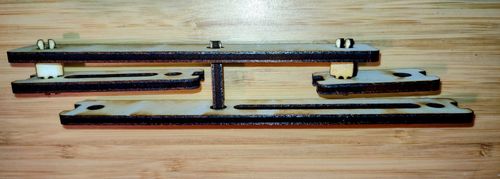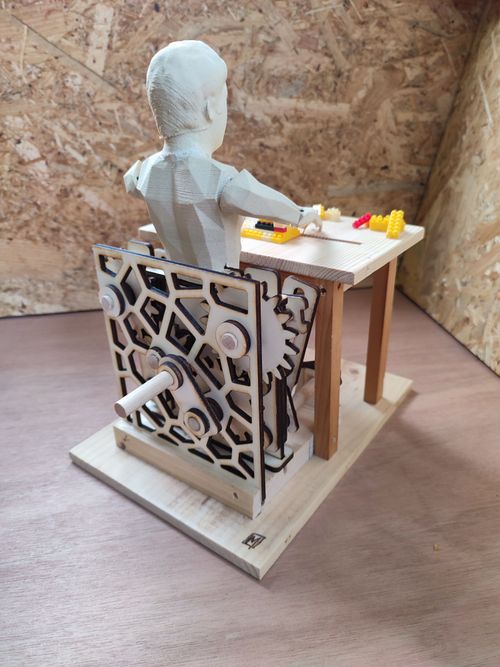LEGO-maker automata
LEGO-maker automata
An automata of a man sitting at a table, playing with LEGO, crafted from laser-cut plywood and 3D-printed wood filament.
/filters:strip_exif()/filters:strip_icc()/filters:blur(4)/14/zHgk357IgE24rxNnl3R7C8IppaYUM4NNkBHaNaLm.jpg)
This project was yet another secret Santa gift for the Belgian maker community on Facebook.
The concept remains the same: you receive someone's Facebook profile and a brief description of their likes or interests, while someone else receives your information. With this information, you begin brainstorming, drawing from any available details about the person.
This year, I was tasked with creating something for an individual who makes amazing creations with LEGO. I also noticed that they had built a a really cool LEGO automaton. Instantly, I knew I wanted to incorporate LEGO into my gift, but I was uncertain about the specifics.
I absolutely love automata. I follow a lot of automata makers online and bought some books the last years. However, I had never actually attempted to create one myself. The idea of a LEGO automaton kept resurfacing in my mind, so I eventually decided to pursue it.
This was the perfect opportunity to try my hand at building a real automaton.
Given that I only had two months to complete the gift, I didn't want to make it overly complex. I guess this is the way to tell "you never made an automaton without telling you never made one" :D
After writing down some ideas, I settled on the concept of a man sitting at a table, engrossed in building something with LEGO.
I envisioned the hands moving from the outer edges towards the center, as if the man were picking up LEGO pieces and placing them in the middle.
Now, I needed to figure out how to translate this movement into a functional mechanism. I conducted some research on potential mechanisms and made a few cardboard prototypes, but the results did not fully satisfy me. However, I felt like I was on the right track. The most challenging part was iterating through various ideas—a lengthy process that involved a lot of trial and error.
So I started searching online for tools, I was sure I wasn't the first one who had this issue. And that's how I stumbled upon Motiongen.io. This tool was a lifesaver! I was so happy with it. In case you're unfamiliar with it, Motiongen.io is an incredible simulator for designing all sorts of 2D mechanisms. It's incredibly user-friendly, and the best part is that it provides instant feedback on how the mechanism would function—or not function.


One particularly amazing feature is the ability to export the model to SVG (and even STL!). I imported these files into Cuttle.xyz, to prepare them for laser cutting. This approach allowed me to iterate much more efficiently, ultimately reaching a functional mechanism a lot faster.

I designed the final mechanism, gears, and the structure to hold everything together in Cuttle.xyz. Cuttle is an amazing tool, it's a versatile web application for parameterizing vector files, making it indispensable for laser projects of all kinds.
A while ago, I developed a gear generator in Cuttle, so this project presented the perfect opportunity to utilize it. Additionally, the Voronoi backplate was also based on a Cuttle project by jbeda.
In Cuttle I arranged all the components exactly where I wanted them and placed gears of various sizes between the two mechanisms—one for each arm—allowing them to be operated by a single crank. After a few minor adjustments, the mechanism ran (almost) perfectly.

I thought that completing the mechanism was the most challenging part—boy, was I wrong.
The next phase involved designing the figurine and determining the overall appearance.
I planned to use my 3D printer to print the figurine, but I had absolutely no idea how to create a figurine :D
Long story short, I tried numerous 3D applications capable of generating 3D models and experimented with various workflows (I nearly abandoned my idea). Eventually, I discovered MakeHuman, a tool that offered an extensive range of options to customize every minute detail of a body. Moreover, it allowed for exporting in various 3D formats—exactly what I needed. However, the exported model had numerous issues, mainly because it consisted of multiple separate parts.
That's when I learned about MeshMixer. I still don't fully comprehend how the app works, but I managed to fix my model.
Even with a static printable model at hand, I still faced the challenge of making it move using my mechanism. Unfortunately, any attempts to cut off the arms resulted in unsightly outcomes, and I didn't have enough time to learn 3D design and create something in a 3D modeling software.
By that point, it was already mid-December, and the deadline of the 22nd was rapidly approaching.
Interestingly, I find that being completely stuck and needing to take a step back can sometimes be beneficial. In many of my projects, this is the point where they end up in the 'abandoned projects closet'. However, I had made a promise to deliver something. Since I had failed with my idea the previous year, I felt compelled to persist :D
I started searching for printable 3D models online, and that's when I stumbled upon this cool-looking marionette model on Thingiverse. I loved its low-poly aesthetic, and the separation between the arms and torso was perfect for my needs. Finally, I saw a glimmer of hope.
During my struggles with the previous model, I managed to export a printable head. So, if I could combine that with the marionette model, I would be good to go.
It was time to print and assemble all the parts.
To achieve the desired wooden appearance, I opted for a light wood filament called LumberJake PLA Naturel by 3D Jake. The prints came out remarkably well, and the finish line was in sight.
However, I encountered yet another obstacle.
During the last prints of the body my nozzle got clogged. I figured that the optimal and fastest fix would be to swap it out with a fresh one. However, when I attempted to change it, it snapped inside the hotend 😱 I tried to remove it in any possible way but only made it worse and damaged my hotend completely.
Luckily, there was a 3D printer company nearby that had a Creality hotend in stock, which I could quickly acquire. I still had two days left :D
During the final stretch, everything went smoothly. Even the miniature LEGO pieces I ordered from AliExpress, which I had given up hope of receiving on time, miraculously arrived that same week. I can't express enough relief, as I had no idea what I would have done without them.
In the end, I was extremely pleased with the result. It surpassed my initial expectations. The mechanism operated (almost) flawlessly, and the arm movements were exactly as I had envisioned. I was so enamored with the final product that I felt a twinge of regret about giving it away to someone I didn't even know. But that's all part of the game :D



Ultimately, the recipient of my gift was also thrilled with it, making all the trials and tribulations worthwhile.
Links

MotionGen
https://motiongen.io/

Cuttle: Generate Personalized SVG Cut Files in seconds
Cuttle is a web-based design tool for laser cutting. Make personalized ornaments, cake toppers, keychains, boxes, jewelry, connected text, and more.
https://cuttle.xyz

www.makehumancommunity.org
MPFB 2.0 alpha 3 has been released. You can find the release notes here:http://static.makehumancommunity.org/mpfb/releases/release_20a3.html
http://makehumancommunity.org/